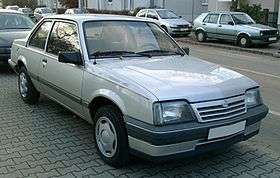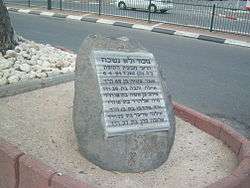Afula bus suicide bombing
| Afula bus suicide bombing | |
|---|---|

The attack site | |
| Location | Afula, Israel |
| Coordinates | 32°36′43.38″N 35°17′16.88″E / 32.6120500°N 35.2880222°E |
| Date |
April 6, 1994 12:15 pm (GMT+2) |
Attack type | Suicide attack |
| Deaths | 8 Israeli civilians (+ 1 bomber) |
Non-fatal injuries | 55 |
| Perpetrators | Hamas claimed responsibility |
The Afula bus suicide bombing was the suicide bombing attack that was carried out on April 6, 1994 at a bus next to an Egged bus in the center of Afula, Israel. Eight Israeli civilians were killed in the attack and 55 additional people were injured. Hamas claimed responsibility for the attack.
The Afula bus suicide bombing was the first suicide bombing attack to be carried out by Palestinian militants against Israeli civilians in Israel,[i][1] and was carried out in retaliation for the killing by a settler of 29 Muslims while they were at prayer in the Ibrahimi mosque in Hebron on February 25.[2]
Preparations for the attack

The Afula bus suicide bombing attack was planned by Hamas chief bombmaker Yahya Ayyash, who began to plan suicide bombings within Israel in 1992.
Ayyash rigged a 1987 Opel Ascona with seven gas cylinders, five anti-personal hand grenades, and wrapped the bomb in a rucksack containing 1,100 carpenter nails.
The attack

Around 11 am, during the Holocaust Memorial Day, a Palestinian suicide bomber, drove a vehicle full of explosives into the division nine street in downtown Afula.
The suicide bomber stopped his vehicle next to an Egged commuter bus line number 348 and detonated the explosives device as the bus was boarding passengers at the bus stop which was crowded with people.
Fatalities
The perpetrators
A few hours after the blast, Hamas issued a communique stating that the bombing was carried out by a 19-year-old Palestinian named Ra'id Zaqarna, who originated from the village of Qabatya in the West Bank and who was a member of the Abdel el-Rahman Hamadan militant cell of the Izz ad-Din al-Qassam Brigades.[11] Zaqarna drove to the intersection of Afula's 9th Brigade (Hativa Tesha) street, and pulled in front of the #348 bus. As a group of Israeli students boarded the bus, Zaqarna detonated the bomb.[12]
Motivation
Hamas publicly declared that the attack was one of 5 planned to retaliate for the Cave of the Patriarchs massacre in which the Hebron settler Baruch Goldstein machine-gunned 29 Muslims at prayer and wounded a further 125. Hamas, after conducted a second attack on April 13, the Hadera bus station suicide bombing, Hamas desisted from undertaking the other three it had planned, when Israel quickened its schedule for withdrawing its military from the Gaza Strip soon after.[2][13]
See also
External links
- FM Peres reaction to Afula attack - 06-Apr-94 - published at the Israeli Ministry of Foreign Affairs
- Incident at Afula - published on The Washington Post on April 7, 1994
- Arab car bomber kills 8 in Israel; 44 are wounded - published on the New York Times on April 7, 1994
- Arafat declines to condemn attack - published on the Jerusalem Post on April 7, 1994
- Us Urges Arafat To Condemn Blast - published on the Milwaukee Sentinel on April 7, 1994
- Israelis' Faith In Peace Is Put Under Strain by Bombing and New Attack - published on the New York Times on April 8, 1994
Footnotes
- ^i The first suicide car bomb attack took place at the Mehola Junction bombing in the West Bank on April 16, 1993. "A year later, on April 6, 1994, Hamas carried out its first successful suicide car bomb attack in Israel proper when a car packed with nearly 400 pounds of explosives detonated beside a bus picking up students in the Israeli town of Afula ..."[14]
References
- ↑ Stork, Joe; Human Rights Watch (2002). Erased in a moment: suicide bombing attacks against Israeli civilians (Illustrated ed.). Human Rights Watch. p. 66. ISBN 978-1-56432-280-7.
- 1 2 Robert Pape Dying to Win: The Strategic Logic of Suicide Terrorism, Random House 2005 pp.66-68
- ↑ Vered Mordechai (Hebrew)
- ↑ Asher Attia (Hebrew)
- ↑ Maya Elharar (Hebrew)
- ↑ Ilana Schreiber (Hebrew)
- ↑ Meirav Ben-Moshe (Hebrew)
- ↑ Ayala Vahaba (Hebrew)
- ↑ Fadiya Shalabi (Hebrew)
- ↑ Ahuva Cohen Onalla (Hebrew)
- ↑ Katz, Samuel (2002). The Hunt for the Engineer. Lyons Press. ISBN 1-58574-749-1., Katz, 103-104
- ↑ Katz, 106
- ↑ Gus Martin (2009). Understanding Terrorism: Challenges, Perspectives, and Issues (3rd, illustrated ed.). SAGE. p. 358. ISBN 978-1-4129-7059-4.
- ↑ Matthew Levitt and Dennis Ross (2007). Hamas: Politics, Charity, and Terrorism in the Service of Jihad (Illustrated ed.). Yale University Press. pp. 11–12. ISBN 978-0-300-12258-9.